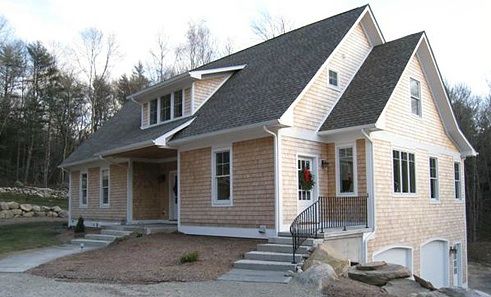
Four of the 11 entries in the 2010-2011 Connecticut Zero Energy Challenge found their way to the winners’ circle, each taking a different path to exemplary energy efficiency performance.
The winner of the $10,000 grand prize, for example, is Sam and Teri Norman’s 2,492-sq.-ft. four-bedroom single-family in Coventry, which posted the lowest combined contest score (including the building’s HERS Index rating), and features geothermal heating and cooling and a PV system, and cost $101 per sq. ft. to construct. With an R-10 slab, R-40 ceiling, and R-33 walls sealed using Huber’s AdvanTech Zip System sheathing and tape, the house relies mostly on its passive-solar design for heat. The Normans say they consider the geothermal system to be a backup source. There’s also a wood stove in a central part of the home, which features an open floor plan.
A 2,800-sq.-ft. two-bedroom in Voluntown, meanwhile, won in the “most affordable” category (measured by cost per sq. ft.), earning homeowners John and Delaine Simonds a Challenge prize of $5,000. This house also relies heavily on its passive solar design for heat, as well as on a geothermal forced-air system for heating and cooling, and a leased photovoltaic system.
A small house wins once and a big house wins twice
The smallest single-family of the 11 entries, a 1,728-sq.-ft. three-bedroom in Ashford, won $5,000 in the Challenge category ranking HERS Index ratings when the entries operate without their renewable-energy systems. This house, whose exterior walls and roof were constructed of structural insulated panels, includes a 4.2 kW photovoltaic system and a geothermal heat pump.
That takes care of three prize categories. But there actually are five prizes in this edition of the Challenge, and the fourth house to win – Bernard Zahren’s 5,327-sq.-ft. five-bedroom in Avon – won the remaining two: $5,000 for the lowest overall HERS Index score (minus 9) and another $5,000 for the lowest projected annual net operating costs. The project has lots of renewables: a geothermal system, solar hot water, and a wind turbine that sits on a 100-ft. tower and can generate about 21,497 kWh of power annually. The house also is designed to accommodate a photovoltaic array on its highest roof.
GreenBuildingAdvisor posted a brief on Zahren’s project as it got underway in 2009 and noted its insulation strategy (R-20 foundation and flooring, R-40 exterior walls, and an R-60 roof) and the fact that it is a renovation of what was a very leaky three-story 3,300-sq.-ft. house.
Sponsors and rules
The contest is sponsored by the Connecticut Energy Efficiency Fund energy conservation initiative and five utilities: Connecticut Light & Power, the United Illuminating Company, Connecticut Natural Gas, Southern Connecticut Gas, and Yankeegas.
Unlike the 2009-2010 edition of the Challenge, there was no size limit on the 2010-2011 entries. The group of 11 projects includes dwellings as small as the 1,576-sq.-ft. units in a set of three duplexes in Hartford and the 1,728-sq.-ft. three-bedroom in Ashford. The largest is a 6,500-sq.-ft. five-bedroom in Avon.
All entries had to be a customer of one of the participating utilities and had to be analyzed and scored by a certified HERS rater before construction began and after construction was completed. Owner-occupied entries eligible for rebates on photovoltaic installations through the Connecticut Energy Efficiency Fund were required to install a PV system. Builders of non-owner-occupied homes, which are not eligible for CEEF rebates, had to design their projects to be PV-ready and, if they didn’t install a system, were given a “simulated” PV system credit of 1 kW per 1,000 sq. ft. of living space.
Fine Homebuilding Recommended Products
Fine Homebuilding receives a commission for items purchased through links on this site, including Amazon Associates and other affiliate advertising programs.

8067 All-Weather Flashing Tape

Handy Heat Gun

Reliable Crimp Connectors


























View Comments
Additional information on the Zahren project, winning two catagories -the lowest overall HERS Index score (minus 9) and the lowest projected annual net operating costs, can be found at the websites of the architect:
Wadsworth Kamm Architects of Glastonbury, Connecticut
WadsworthKamm.com
Facebook.comWadsworth-Kamm-Architects
And on the website of the General contractor:
Gable Construction of Portland Connecticut
GableConstruction.com